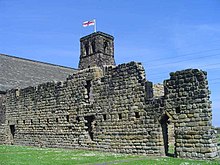Monkwearmouth-Jarrow Monastery
The Monkwearmouth-Jarrow Monastery, also known as St. Paul Monastery, was a Benedictine monastery in Northumbria in England that existed from the 7th to the 16th century . In the 7th and 8th centuries it was one of the most important monasteries in England.
history
In 674 a monastery was founded in Monkwearmouth by King Egfrid of Northumbria . First abbot was Benedict Biscop , with him also came Beda . In 678 the monastery was exempt . In 682 another monastery was founded in Jarrow .
In 686 this became independent, Ceolfrid became abbot . Jarrow soon became a unique manuscript-making center. Among other things, the oldest surviving complete Vulgate Bible ( Codex Amiatinus ) and other illuminated biblical, liturgical and theological manuscripts were created.
In 794 the monastery was attacked by Vikings . Around 860 it was badly damaged by the Danes . The monastery was abandoned by the end of the 9th century at the latest. From around 1070 monks lived in Jarrow again, but not as an independent monastery. In 1545 monastic life in Jarrow ended.
The former monasteries in Monkwearmouth and Jarrow are now ruins. In Jarrow, the "Bede's world" museum reports on the first centuries of the monastery.
Scriptorium
One of the few scriptoria in Europe existed in Jarrow in the late 7th century . Beda Venerabilis wrote his English church history here (around 731). The monastery presumably had an extensive library with numerous theological and secular works, partly of Italian-Roman origin.
Originated in the monastery
- Codex Amiatinus , around 700, oldest surviving Vulgate manuscript ever
- John's Gospel , oldest surviving hardback book in Europe, full text of the Gospel (without decorations)
- Cassiodorus: Expositio psalmorum , abridged version of a late antique psalm commentary
- Beda Venerabilis: Historia ecclesiastica gentis Anglorum , after 737, one of the two oldest surviving copies of Beda's church history, not illuminated
- Beda Venerabilis: Historia ecclesiastica gentis Anglorum , between 731 and 746, manuscript with the oldest surviving illuminated initial in Europe
Web links
literature
- Rosemary Cramp : Wearmouth and Jarrow Monastic Sites. 2 volumes, English Heritage, Swindon 2005–2006, ISBN 1-873-59293-0 and ISBN 1-873-59294-9 (online: Volume 1 , Volume 2 ) (not evaluated).
References and comments
- ↑ Other important monastic writing centers were e.g. B. the monastery of Luxeuil, see the Lectionary of Luxeuil [1]
Coordinates: 54 ° 54 ′ 47.2 " N , 1 ° 22 ′ 29.6" W.

